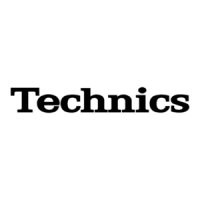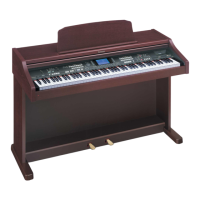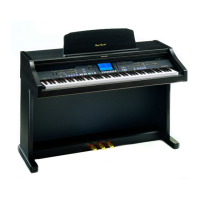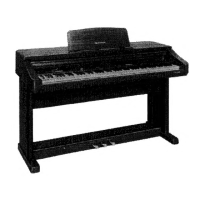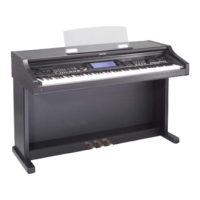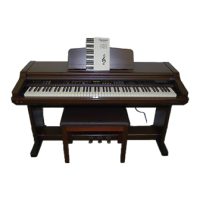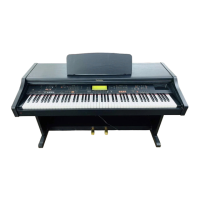
Do you have a question about the Technics sx-PR51 and is the answer not in the manual?
| Type | Digital Piano |
|---|---|
| Effects | Reverb, Chorus |
| MIDI | Yes |
| Metronome | Yes |
| Transpose | Yes |
| Tuning | Yes |
| Keyboard | 88 keys |
| Tones | Piano, Strings, Organ |
| Recorder | 2-track |
| Speakers | Yes |
| Touch Sensitivity | 3 levels |
| Built-in Songs | Yes |
| Headphone Jack | Yes |
| Pedals | Damper, Soft, Sostenuto |
| Finish | Rosewood |
Select standard piano or other performance styles.
Create and store original rhythm patterns.
Choose preset automatic rhythm patterns.
Listen to programmed demonstration tunes.
Use piano styles and accompaniment patterns.
Automatically select sounds and tempo.
Information on the instrument's tuning.
Select sounds for right 1 and right 2 parts.
Record and play back performances.
Add various effects to sounds.
Shows performance information and settings.
Store current panel settings for recall.
Steps to connect power and turn the instrument on.
Adjusting the main volume level.
Instructions for attaching the music stand.
Initiating and controlling the demonstration playback.
Using PAGE buttons to choose demonstration songs.
Controlling the demo playback with START/STOP.
Activating the piano mode for playing.
Selecting from the four available piano sounds.
Basic instruction to play notes on the keyboard.
Using the RIGHT buttons to select sounds.
Choosing sound groups for different parts.
Using sound select buttons to choose specific sounds.
Applying digital reverb effect to the sound.
Choosing a rhythm group for accompaniment.
Using rhythm select buttons to choose a rhythm.
Using variation buttons to select rhythm variations.
Starting rhythm playback with START/STOP.
Methods to adjust the rhythm tempo.
Adding an intro pattern before rhythm starts.
Adding a fill-in pattern during rhythm playback.
Adding an ending pattern to stop the rhythm.
Using the Piano Stylist feature with accompaniment.
Pressing the EXECUTE button to start accompaniment.
Using UP/DOWN buttons to select a style group.
Demonstrates playing C, F, G7 chords for accompaniment.
Details on setting up and using the Piano Stylist.
How to insert a song disk into the disk drive slot.
Turning on the MEMORY & CONTROL button.
Using PAGE buttons to select songs.
Using LEFT/RIGHT buttons to select songs.
Details shown on the display during normal performance.
Adjusting volume balance using bar graphs.
Showing part balance display for Metronome, RBas, Chd.
Navigating between different 'pages' of the display.
Using buttons to access various menu displays.
Display example for sound setting menu.
Display example for setting mode like Left Hold.
Returning to the previous display from setting menus.
Maintaining the current display information.
Using MEMORY & CONTROL and PAGE buttons.
Using LEFT/RIGHT buttons to adjust contrast.
Standard piano and performance styles.
Using the instrument as a standard piano.
Dividing the keyboard into two playing areas.
Using chords for automatic accompaniment.
Selecting sounds for right 1 and right 2 parts.
Choosing from GRAND, UPRIGHT, ELECTRIC, MODERN.
Choosing sounds for Right 1 or Right 2.
Selecting from categories like PIANO, BRASS, etc.
Playing percussion instrument sounds.
Combining sounds for Right 1 and Right 2 parts.
Dividing keyboard for different sounds in left/right sections.
Indicating the split point with G2, C3, C4.
Setting a custom split point location.
Using the sustain pedal for sustained notes.
Using the soft pedal for softer tones.
Adjusting string resonance for acoustic piano sounds.
Applying digital effects for sound richness.
Adding breadth to the sound with chorus.
Adding reverberation effect to the sound.
Using transpose buttons to change the instrument's key.
Creating full melodies with harmony chords.
Choosing desired harmony styles for Techni-Chord.
Using Orchestrator for melody and harmony notes.
Choosing desired rhythms from the display.
Using VARIATION & MSA buttons for variations.
Starting rhythm playback with START/STOP.
Starting rhythm when a key is played.
Tempo adjustment for rhythm patterns.
Starting rhythm performance with an intro pattern.
Starting rhythm performance with a one-measure count.
Inserting fill-in patterns during rhythm playback.
Adding an ending pattern to stop the rhythm.
Automatic chord accompaniment based on melody.
Using one finger to specify root notes for chords.
Playing chords by pressing multiple keys.
Specifying chords for advanced modes.
Specifying chords for advanced modes.
Using pianist mode for automatic accompaniment.
Using the ON BASS button for specific chords.
Holding accompaniment for solo melody.
Choosing rhythm and tempo for Auto Play Chord.
Setting the Auto Play Chord mode.
Determining accompaniment patterns.
Setting up and using the Piano Stylist feature.
Pressing EXECUTE to confirm style selection.
Setting up instrument for one-touch play.
Choosing rhythm patterns for One Touch Play.
Setting up instrument with style names.
Choosing rhythm groups for music styles.
Defining panel settings for performance changes.
Modifying performance with fill-in patterns.
Storing and recalling panel settings.
Storing panel settings in Normal and Expand modes.
Specifying data recalled in Expand mode.
Controlling functions via the sustain (left) pedal.
Overview of sequencer capabilities like pitch change, sound quality.
Easy Record, Create a preset, Store a chord progression.
Information on storage capacity for sequencer data.
Summary of sequencer menu items like Record, Track Assign.
Recording performances and saving them.
Assigning tracks and editing them.
Playing back recorded songs and medleys.
Using MENU and ACCOMP buttons to select songs.
Assigning names to recorded songs.
Following procedures to record and play back songs.
Steps for recording and playback.
Playing back recorded performances.
Summary of parts stored in sequencer and their uses.
List of default part assignments.
Steps for recording performance in real-time.
Tempo adjustment for recording.
Using metronome for recording.
Recording measures continuously.
Setting number of measures for recording.
Choosing songs for playback.
Using START/STOP, RESET buttons for playback.
Choosing songs for cycle playback.
Using START/STOP, RESET for cycle playback.
Recording chord progressions for Auto Play Chord.
Explanation of note value keys.
Using the reset key.
Entering chords for the progression.
Modifying the stored chord progression.
Storing and managing chord data.
Erasing data from a track.
Storing rhythm and tempo data.
Modifying the recorded rhythm progression.
Erasing rhythm data.
Assigning tracks to parts as needed.
Using preset track assignments.
Choosing functions like Song Clear or Track Clear.
Erasing the recorded contents of a song.
Erasing specific tracks.
Correcting timing of performance.
Copying recorded data from specific tracks.
Changing panel status.
Playing songs back continuously in order.
Using PAGE, ACCOMP buttons for medley playback.
Creating accompaniment patterns and editing rhythms.
Storing up to 12 different rhythm variations.
Information on composer memory capacity.
Summary of composer menu items like Record, Copy.
Editing preset rhythms or creating new ones.
Choosing pattern and bank for editing.
Copying patterns to memory banks.
Typing new names for rhythm patterns.
Choosing pattern and bank for new rhythm creation.
Assigning a name to the new rhythm pattern.
Setting number of measures and time signature.
Recording rhythm parts, including drums.
Steps to record a rhythm pattern on the keyboard.
Using functions like Clear and Quantize.
Playing back recorded rhythm patterns.
Choosing between Normal and Expand modes.
Selecting chord maps for accompaniment.
Recalling stored chord maps.
Assigning maps to pattern numbers.
Assigning names to chord maps.
Storing Composer, Sequencer data for future use.
Types of storage available.
Loading songs from disks.
Playing commercial songs directly from disk.
Identifying parts like disk slot, eject button.
Steps for using disk drive functions.
Steps for loading data into the instrument.
Selecting Technics File, SMF, Composer data.
Loading data saved in Technics File format.
Loading Standard MIDI File data.
Loading SMF data and selecting songs.
Loading composer data into memory.
Playing commercial songs directly.
Using SMF disks for direct play.
Procedure to format disks.
Differentiating between 2DD and 2HD disks.
Saving panel settings and data to disk.
Saving data in Technics File format.
Saving Sequencer, Composer, Panel Memory data.
Deleting files from the disk.
Saving data in Standard MIDI File format.
Saving songs and panel settings.
Deleting SMF files.
Adjusting sound, tone, volume, and effects.
Summary of sound menu options.
Adjusting volume for Right 1 part.
Adjusting stereo balance, reverb depth, and tuning.
Enabling or disabling key scaling.
Selecting keyboard touch response mode.
Fine-tuning the pitch of the entire instrument.
Choosing different temperaments for scaling.
Customizing the pitch of each note.
Specifying how left section sounds during Auto Play Chord.
Explanation of Musical Instrument Digital Interface.
Identifying MIDI IN and OUT terminals.
Illustrations of MIDI connection setups.
Explanation of MIDI channels and data transmission.
Types of data transmitted/received (Note, Control, Program, Exclusive).
Standard for MIDI data compatibility.
Selecting various settings for MIDI operation.
List of MIDI menu items and their pages.
Assigning MIDI channels to parts.
Table of default MIDI channel assignments.
Setting octave shift for key notes.
Enabling/disabling local control.
Configuring common settings for all parts.
Changing program numbers for sounds.
Controlling various data exchange.
Setting Pitch Bend, Reverb, Tuning, etc.
Configuring settings for data transmission and reception.
Selecting output items like Techni-Chord, Drums.
Enabling/disabling Start/Stop, Continue, Clock commands.
Establishing optimum instrument connection.
Standard for MIDI data compatibility.
Setting GM mode to On or Off.
Returning settings to factory presets.
Information about power settings and defaults.
Details on Line Out, Aux In, MIDI, Pedal In.
Connecting headphones for private listening.
Identifying the parts included in the assembly kit.
Steps to assemble the piano body onto the stand.
Connecting pedal and power cord terminals.
Using screws to secure the piano body.
Ensuring proper connection of the power cord.
Checking for secure connections and power cable installation.
Remedies for buttons, keys, etc. not working.
Troubleshooting when no sound is produced.
Resolving issues with selecting sounds.
Resolving issues with rhythm playback.
Troubleshooting accompaniment problems.
Resolving multi-track and playback measurement differences.
Resolving timing and measure number issues.
Troubleshooting disk noise and data erasure.
Addressing cabinet warmth and radio interference.
Messages related to disk operations like WRONG DISK, NO DISK.
Messages about memory full or data protection.
Messages related to SMF format and track assignments.
Messages indicating insufficient memory.
Details on sound generation, play styles, and groups.
Specifications for rhythms, metronome, and controls.
Details on composer functions and memory.
Specifications for MIDI and external storage.
Information on power requirements and physical dimensions.
